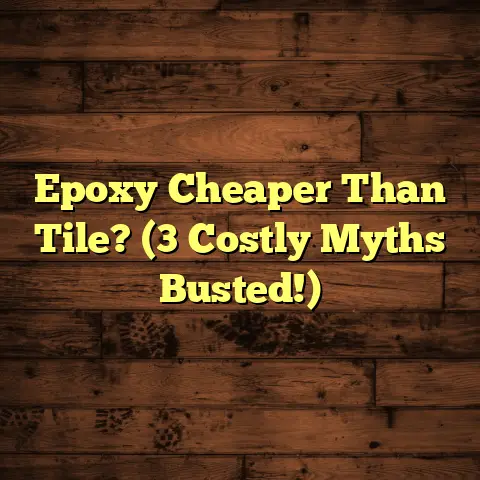Hickory Barrel Floors: Worth the Cost? (Price Shock!)
I’ve installed everything from basic laminate to exotic hardwoods, and I’ve gotta say, hickory barrel flooring has a certain je ne sais quoi.
It’s got that rustic charm combined with a touch of elegance that can transform any space.
But let’s be real – it comes with a price tag that can make your eyes water.
So, is it worth the splurge? That’s what we’re going to unpack today.
We’ll explore the ins and outs of hickory barrel floors, from their unique characteristics to their environmental impact and, of course, that all-important cost analysis.
Think of this as your ultimate guide to deciding if hickory barrel flooring is the right choice for your dream home.
Trust me, by the end of this, you’ll have all the info you need to make an informed decision.
Let’s get started!
Introduction
Hickory barrel floors. The name alone conjures images of cozy cabins, rustic farmhouses, and stylish lofts.
They’re incredibly adaptable, fitting seamlessly into a wide range of design aesthetics.
Whether you’re going for a modern industrial vibe or a classic country feel, hickory barrel floors can be the perfect foundation.
But before we get carried away with design dreams, let’s talk about the basics.
Hickory, as a wood, has been a workhorse for centuries.
Think tool handles, wagon wheels, and furniture that’s built to last.
Its strength and durability are legendary.
Now, imagine taking that same robust wood and repurposing it from old barrels.
That’s the essence of hickory barrel flooring.
These aren’t your run-of-the-mill planks.
They’re crafted from reclaimed barrels, adding a unique story and character to every floor.
The rising popularity of these floors is undeniable.
Homeowners are drawn to their distinctive look, their eco-friendly nature, and the sense of history they bring to a space.
But here’s the kicker: this unique appeal comes at a cost.
A cost that can leave you wondering if the beauty and story are truly worth the investment.
In this article, we’ll break down everything you need to know about hickory barrel floors.
We’ll explore the characteristics of hickory wood, the process of creating these floors, the environmental impact, and, most importantly, the cost analysis.
We’ll also delve into the aesthetic appeal and design versatility, consumer perspectives, and market trends.
By the end, you’ll have a clear understanding of whether hickory barrel floors are the right choice for you.
So, buckle up and get ready to dive into the world of hickory barrel flooring!
Section 1: Understanding Hickory as a Material
Alright, let’s get down to the nitty-gritty.
What exactly is hickory, and why is it such a desirable material for flooring?
1.1 Characteristics of Hickory Wood
Hickory is a hardwood known for its exceptional strength and durability.
In fact, it’s one of the hardest and most shock-resistant hardwoods available in North America.
On the Janka hardness scale, which measures the resistance of wood to denting and wear, hickory typically scores between 1820 and 2000.
Compare that to oak, which ranges from 1290 to 1360, and you can see why hickory is often praised for its toughness.
This hardness translates to a floor that can withstand heavy foot traffic, resist scratches and dents, and generally hold up beautifully over time.
Beyond its strength, hickory also boasts a unique grain pattern and color variation.
You’ll find everything from creamy whites and light browns to rich reddish-browns and even darker hues.
This natural variation adds character and visual interest to the floor, making each installation truly one-of-a-kind.
I’ve seen floors where the color variations create a stunning, almost mosaic-like effect.
When comparing hickory to other popular flooring materials, it’s important to consider the specific needs and aesthetic preferences of your space.
-
Oak: A classic choice, oak is readily available and generally more affordable than hickory. It’s also durable, but not quite as hard as hickory.
-
Maple: Maple offers a cleaner, more uniform look with a lighter color palette. It’s also a hard wood, but again, not quite as resistant to wear as hickory.
-
Cherry: Cherry is known for its rich, reddish-brown color and smooth grain. It’s a softer hardwood, making it more susceptible to dents and scratches.
In my experience, hickory is an excellent choice for high-traffic areas, homes with pets or children, or anyone who wants a floor that can stand up to the rigors of daily life.
1.2 The Process of Creating Hickory Barrel Floors
Now, let’s talk about how these unique floors are actually made.
The process of creating hickory barrel floors starts with sourcing reclaimed barrels.
These barrels are typically sourced from distilleries and wineries, where they’ve spent years aging whiskey, wine, or other spirits.
The aging process is crucial because it infuses the wood with unique flavors, aromas, and colors.
The wood absorbs the tannins and other compounds from the spirits, creating a depth of character that you simply can’t replicate with new wood.
Once the barrels are sourced, they’re carefully disassembled, and the staves (the individual wooden planks that make up the barrel) are cleaned and prepared.
This is where the real craftsmanship comes in.
Skilled artisans carefully select and sort the staves, paying attention to the grain pattern, color, and overall appearance.
They then mill the staves into flooring planks, taking care to preserve the unique character and markings of the original barrel.
You might see nail holes, staining from the spirits, or even the cooper’s marks (the symbols used by the barrel maker).
These imperfections are what give hickory barrel floors their distinctive charm and tell their story.
The planks are then kiln-dried to ensure stability and prevent warping or cupping.
Finally, they’re finished with a durable coating to protect the wood and enhance its natural beauty.
The entire process is labor-intensive and requires a high level of skill and attention to detail.
This is one of the reasons why hickory barrel floors tend to be more expensive than other flooring options.
1.3 Environmental Impact and Sustainability
In today’s world, sustainability is a major concern for many homeowners.
The good news is that hickory barrel floors are an environmentally friendly choice.
By using reclaimed wood, you’re helping to reduce waste and conserve natural resources.
Instead of cutting down new trees, these floors give a second life to wood that would otherwise be discarded.
This reduces the demand for virgin timber and helps to preserve our forests.
Additionally, the process of creating hickory barrel floors often involves less energy and fewer chemicals than manufacturing new flooring.
This further reduces the environmental footprint of the product.
Many manufacturers of hickory barrel flooring are also committed to sustainable practices, such as using eco-friendly finishes and adhesives.
When shopping for hickory barrel floors, look for certifications or standards that indicate the product’s sustainability.
For example, the Forest Stewardship Council (FSC) certification ensures that the wood comes from responsibly managed forests.
The Leadership in Energy and Environmental Design (LEED) program also recognizes the use of reclaimed materials in construction projects.
By choosing hickory barrel floors, you can create a beautiful and sustainable home that you can feel good about.
Section 2: Cost Analysis of Hickory Barrel Floors
Okay, let’s talk about the elephant in the room: the cost.
Hickory barrel floors are undoubtedly a premium flooring option, and their price tag reflects that.
But to truly understand the cost, we need to break it down and compare it to other options.
2.1 Price Breakdown
The cost of hickory barrel flooring can vary depending on several factors, including the manufacturer, the quality of the wood, and the complexity of the installation.
However, here’s a general breakdown of the costs you can expect:
-
Raw Materials: The cost of sourcing and processing reclaimed barrels is a significant factor. Expect to pay more for barrels from renowned distilleries or wineries.
-
Processing: Milling, drying, and finishing the planks requires specialized equipment and skilled labor. This adds to the overall cost.
-
Installation: Installing hickory barrel floors can be more complex than installing traditional hardwood floors, especially if you’re dealing with irregular plank sizes or unique patterns.
On average, you can expect to pay anywhere from $15 to $30 per square foot for hickory barrel flooring, installed.
That’s significantly more than other flooring options, such as:
- Laminate: $3 – $7 per square foot, installed
- Vinyl: $4 – $10 per square foot, installed
- Traditional Hardwood (Oak): $8 – $15 per square foot, installed
As you can see, hickory barrel flooring is a premium choice that comes with a premium price.
2.2 Factors Influencing Pricing
Several factors can influence the price of hickory barrel floors.
Understanding these factors can help you make a more informed decision and potentially find ways to save money.
-
Market Demand: Like any product, the price of hickory barrel flooring is influenced by supply and demand. As more homeowners seek out this unique flooring option, the demand increases, which can drive up prices.
-
Sourcing Challenges: Sourcing high-quality reclaimed barrels can be challenging. The availability of barrels from specific distilleries or wineries can also affect the price.
-
Craftsmanship: The level of craftsmanship involved in creating hickory barrel floors is a significant factor. Floors that are carefully milled, finished, and inspected will generally command a higher price.
-
Regional Price Variations: Prices can also vary depending on your location. Areas with higher labor costs or limited access to reclaimed barrels may see higher prices.
I’ve found that working directly with a local manufacturer or supplier can sometimes help you get a better price.
They may be able to offer discounts or specials that aren’t available through retail channels.
2.3 Long-Term Investment vs. Short-Term Costs
It’s easy to get sticker shock when you see the initial price of hickory barrel flooring.
However, it’s important to consider flooring as a long-term investment.
While the upfront cost may be higher, hickory barrel floors can offer significant benefits over time.
-
Durability: As we discussed earlier, hickory is an incredibly durable wood. A well-maintained hickory barrel floor can last for decades, even in high-traffic areas.
-
Resale Value: High-quality flooring can increase the value of your home. Hickory barrel floors are a unique and desirable feature that can attract potential buyers.
-
Unique Aesthetic: The beauty and character of hickory barrel floors are unmatched. They can transform a space and create a warm, inviting atmosphere.
I had a client who installed hickory barrel flooring in their living room.
They were initially hesitant about the cost, but they fell in love with the unique look and the story behind the wood.
Years later, when they decided to sell their home, the flooring was a major selling point.
Potential buyers were drawn to the character and charm of the floor, and it ultimately helped them sell the house for a higher price.
Of course, every situation is different, and there’s no guarantee that hickory barrel flooring will increase your home’s value.
But if you appreciate the aesthetic appeal, the durability, and the sustainability of this flooring option, it can be a worthwhile investment.
Section 3: Aesthetic Appeal and Design Versatility
Let’s move on to the fun part: the aesthetics!
Hickory barrel floors aren’t just durable and sustainable; they’re also incredibly beautiful.
3.1 Visual Characteristics of Hickory Barrel Floors
The visual appeal of hickory barrel floors is undeniable.
The combination of natural color variations, unique grain patterns, and the character marks from the barrels creates a floor that is both rustic and elegant.
You’ll find a range of colors, from light tans and browns to deep reds and even hints of purple, depending on the type of spirit that was aged in the barrel.
The grain patterns can be straight, wavy, or even burled, adding to the visual interest.
And then there are the character marks: nail holes, staining from the spirits, cooper’s marks, and other imperfections that tell the story of the barrel’s past.
These imperfections aren’t flaws; they’re part of the floor’s charm and history.
I’ve seen installations where the color variations and character marks create a stunning, almost three-dimensional effect.
It’s like having a piece of art under your feet.
3.2 Compatibility with Different Interior Styles
One of the great things about hickory barrel floors is their versatility.
They can complement a wide range of interior design styles, from rustic and farmhouse to modern and industrial.
-
Rustic/Farmhouse: Hickory barrel floors are a natural fit for rustic and farmhouse styles. They add warmth, character, and a sense of history to the space. Pair them with natural wood furniture, exposed beams, and vintage accents for a cozy and inviting feel.
-
Modern/Industrial: Believe it or not, hickory barrel floors can also work well in modern and industrial settings. The contrast between the rustic wood and the sleek, contemporary elements can create a striking visual effect. Combine them with metal accents, concrete walls, and minimalist furniture for a cool and edgy look.
-
Transitional: For a more balanced approach, hickory barrel floors can be used in transitional designs. This style blends traditional and contemporary elements, creating a timeless and sophisticated look.
When choosing furniture and décor to pair with hickory barrel floors, consider the color palette and the overall style of the room.
Natural wood tones, warm colors, and textured fabrics tend to work well with hickory.
I often recommend using area rugs to define different spaces within the room and add a pop of color or pattern.
3.3 Trends in Flooring Design
The flooring industry is constantly evolving, with new materials, styles, and technologies emerging all the time.
One of the biggest trends in recent years has been the growing popularity of reclaimed wood.
Homeowners are increasingly drawn to the unique character, sustainability, and sense of history that reclaimed wood offers.
Hickory barrel floors fit perfectly into this trend.
They offer all the benefits of reclaimed wood, plus the added appeal of being crafted from aged barrels.
Another trend in flooring design is the move towards wider planks.
Wider planks create a more spacious and luxurious feel, and they also showcase the natural beauty of the wood.
Many manufacturers of hickory barrel flooring offer wider planks, allowing you to create a stunning and contemporary look.
In general, consumers today are looking for flooring that is durable, sustainable, and aesthetically pleasing.
Hickory barrel floors tick all of these boxes, making them a popular choice for homeowners who want the best of both worlds.
Section 4: Consumer Perspectives and Market Demand
Now, let’s take a look at what consumers are saying about hickory barrel floors and how they’re performing in the market.
4.1 Surveying Consumer Opinions
I’ve had the opportunity to talk to many homeowners who have chosen hickory barrel floors, and their feedback is overwhelmingly positive.
They often cite the unique aesthetic appeal, the durability, and the sustainability as the main reasons for their choice.
Many also appreciate the story behind the wood and the sense of history it brings to their homes.
Here are some common themes that emerge from these conversations:
-
Love the Look: Homeowners consistently praise the beauty and character of hickory barrel floors. They appreciate the natural color variations, the unique grain patterns, and the character marks that tell the story of the wood.
-
Durable and Long-Lasting: Many homeowners choose hickory barrel floors because they want a floor that will stand up to the rigors of daily life. They’re impressed with the durability and the resistance to wear and tear.
-
Eco-Friendly Choice: Sustainability is a major concern for many homeowners, and they appreciate that hickory barrel floors are an environmentally friendly choice.
However, some homeowners also express concerns about the cost of hickory barrel flooring.
They acknowledge that it’s a premium option, but they wonder if the benefits justify the price.
4.2 Consumer Demographics
The demographics of consumers purchasing hickory barrel flooring tend to be relatively affluent and environmentally conscious.
They’re often homeowners who are willing to invest in high-quality materials and finishes that will last for years to come.
They also tend to be interested in sustainable living and appreciate the eco-friendly aspects of reclaimed wood.
Here’s a general overview of the demographics:
- Age: Typically between 35 and 65 years old
- Income Level: Middle to upper-income households
- Lifestyle: Value quality, sustainability, and unique design elements
- Location: Often found in urban areas or rural communities with a strong appreciation for craftsmanship and natural materials
These factors influence purchasing decisions and preferences.
For example, homeowners with young children may prioritize durability and ease of maintenance, while those who entertain frequently may focus on the aesthetic appeal and the ability to create a stylish and inviting space.
4.3 Market Trends
The market for hickory barrel floors is growing steadily, driven by the increasing demand for reclaimed wood and sustainable building materials.
Sales data and forecasts indicate that this trend is likely to continue in the coming years.
Several economic factors can affect the demand for premium flooring options, such as:
-
Inflation: Rising inflation can make homeowners more cautious about spending on luxury items, including premium flooring.
-
Housing Market Trends: A strong housing market can boost demand for home renovations and improvements, which can lead to increased sales of hickory barrel flooring.
-
Interest Rates: Higher interest rates can make it more expensive for homeowners to borrow money for home improvement projects, which can dampen demand for premium flooring.
Despite these economic challenges, the market for hickory barrel floors remains strong.
Homeowners are increasingly willing to invest in high-quality, sustainable materials that will add value and beauty to their homes.
Conclusion
So, we’ve reached the end of our deep dive into the world of hickory barrel floors.
We’ve explored the characteristics of hickory wood, the process of creating these floors, the environmental impact, the cost analysis, the aesthetic appeal, and the consumer perspectives.
It’s clear that hickory barrel floors are a unique and desirable flooring option that offers a range of benefits.
They’re durable, sustainable, and incredibly beautiful, with a character and charm that you simply can’t find in other flooring options.
But are they worth the cost?
That’s a question that only you can answer.
The price of hickory barrel flooring is undeniably higher than other options.
But when you consider the long-term benefits, the sustainability, and the unique aesthetic appeal, it may be a worthwhile investment.
If you value quality, sustainability, and unique design elements, and if you’re willing to invest in a floor that will last for decades, then hickory barrel flooring may be the perfect choice for you.
But if you’re on a tight budget or if you’re not particularly concerned about sustainability, then there may be other flooring options that are a better fit.
Ultimately, the decision comes down to your individual needs, preferences, and budget.
I hope this article has given you the information you need to make an informed decision and to weigh the pros and cons of investing in hickory barrel flooring for your home.
Thanks for joining me on this journey! Happy renovating!





